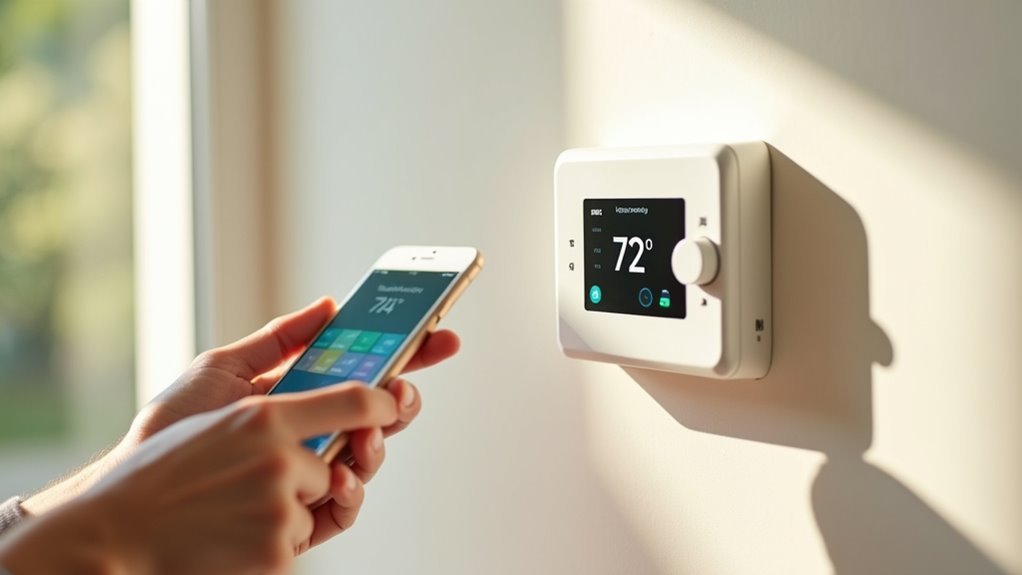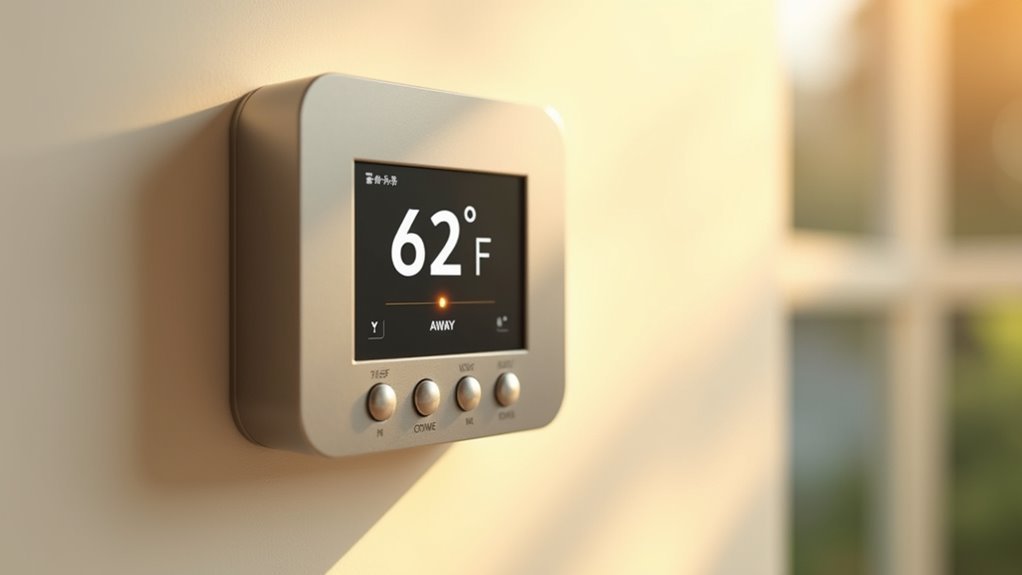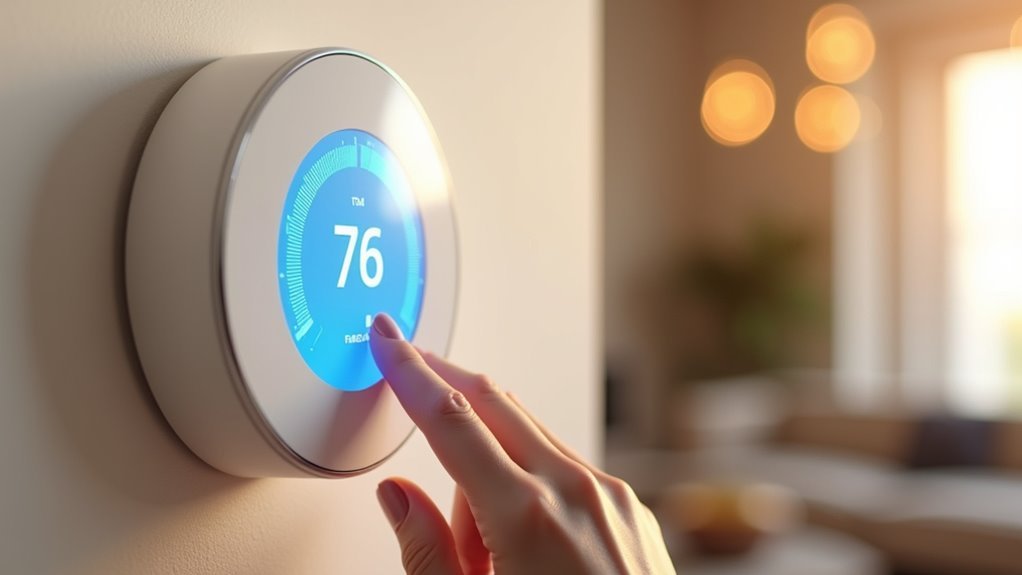You’re probably losing money every month because your thermostat isn’t working as efficiently as it could. Most homeowners set their thermostats once and forget about them, missing out on significant energy savings and comfort improvements. Smart programming techniques can reduce your heating and cooling costs by up to 23% while maintaining perfect indoor temperatures. These proven strategies will transform how your HVAC system operates throughout the day.
Master Your Daily Schedule Programming

When you’re setting up your thermostat’s daily schedule, start by mapping out your household’s routine throughout a typical week. Document wake-up times, when family members leave, return home, and go to bed. This information becomes the foundation for effective thermostat programming that maximizes energy savings.
Document your family’s daily routine—wake-up times, departures, arrivals, and bedtimes—to create an energy-efficient thermostat schedule that works.
A 7-day programmable thermostat offers the flexibility you need for varying daily schedules. Set three distinct temperature settings: “home,” “away,” and “sleeping.” For ideal energy efficiency, program setbacks of 7-10°F during unoccupied periods. Your home temperature can automatically adjust without sacrificing comfort.
Review these settings seasonally, aiming for 68°F in winter and 78°F in summer as baseline temperatures.
Most importantly, verify your programmed schedule activates correctly by following manufacturer instructions, preventing unnecessary energy consumption.
Leverage Geofencing for Automatic Temperature Adjustments
While traditional programmable schedules work well for consistent routines, geofencing technology takes your smart thermostat’s efficiency to the next level by automatically responding to your actual location.
When you leave a predefined perimeter around your home, geofencing triggers your smart thermostats to adjust temperature settings by 7-10°F, considerably reducing unnecessary HVAC operation during unoccupied hours.
You’ll achieve energy savings of 10-20% on your utility bills without sacrificing comfort. The system detects when you’re approaching home and preemptively adjusts temperatures for your arrival.
Optimize Temperature Setbacks During Unoccupied Hours

Beyond location-based automation, strategic temperature setbacks during unoccupied hours form the foundation of effective thermostat programming.
You’ll achieve maximum energy efficiency by lowering your temperature 7-10°F during nights and absences, reducing heating and cooling needs by 10-30%. This translates to significant energy savings on monthly bills without sacrificing comfort.
Programmable thermostats and smart thermostats excel at automating these adjustments, eliminating manual changes while minimizing energy waste.
You can schedule setbacks around your typical occupancy patterns, ensuring ideal performance year-round.
Don’t set-and-forget your programming.
Regularly review and adjust setback schedules as your routines change or seasons shift. This ongoing improvement maintains peak energy efficiency while adapting to evolving lifestyle needs, maximizing both comfort and cost savings.
Utilize Learning Capabilities to Enhance Efficiency
As your household routines become established, learning thermostats transform these patterns into automated energy savings that adapt without constant reprogramming.
These smart thermostats analyze your temperature preferences over weeks and months, creating a personalized schedule that eliminates manual adjustments. Programming your thermostat becomes effortless as algorithms detect when you’re typically home or away, automatically implementing setbacks to reduce energy consumption.
The learning capabilities extend beyond basic scheduling. Advanced models utilize geofencing technology to track your location, ensuring comfortable temperatures upon arrival while maximizing energy efficiency during absences.
Regular software updates continuously improve these algorithms, refining their accuracy and enhancing performance. You’ll benefit from proactive temperature adjustments that anticipate your needs, delivering consistent comfort while achieving 10-15% energy savings automatically.
Integrate Smart Home Automation for Seamless Control

You can maximize your thermostat’s potential by integrating it with your smart home ecosystem for effortless control.
Voice control integration lets you adjust temperatures hands-free using Alexa or Google Assistant, eliminating the need to manually operate your device.
Setting up geofencing automation takes convenience further by automatically adjusting your home’s temperature based on your location, ensuring energy savings when you’re away.
Voice Control Integration
How often do you find yourself across the room when you need to adjust your thermostat? Voice control integration with smart thermostats eliminates this inconvenience entirely.
You can make temperature adjustments hands-free using Amazon Alexa or Google Assistant through simple commands. Tell your voice assistant to set a schedule, change temperatures, or check energy usage without touching the thermostat interface.
This integration promotes consistent temperature management and supports energy-saving practices. You’ll easily lower temperatures when leaving home or raise them before returning, optimizing your heating and cooling based on real-time occupancy.
Voice control creates a cohesive automation system that greatly enhances energy efficiency. Studies show you can achieve 10-20% savings on energy bills through optimized thermostat settings enabled by voice commands.
Geofencing Automation Setup
Multiple location zones transform your thermostat into an intelligent system that anticipates your needs before you walk through the door.
Geofencing automation uses GPS technology to automatically adjust thermostat settings based on your location, maximizing energy efficiency by reducing heating or cooling when you’re away. You can customize your geofencing radius to determine exactly how far from home triggers energy-saving modes, ensuring ideal temperature control upon your return.
Smart home integration elevates this automation by connecting your thermostat with security systems and lighting for seamless operation.
Create multiple zones for different locations like work or vacation spots, each with unique temperature preferences. Regular firmware updates improve geofencing accuracy, keeping your system responsive to lifestyle changes while maintaining efficient climate control.
Program Seasonal Adjustments for Year-Round Savings
While many homeowners set their thermostats once and forget about them, programming seasonal adjustments can dramatically reduce your energy bills throughout the year.
Smart thermostats make this process effortless by allowing you to create distinct heating and cooling schedules for each season.
For winter energy efficiency, program your thermostat settings to 68°F during the day and drop them 7-10°F when you’re sleeping or away.
Summer programming should maintain 78°F while home, rising to 85°F when absent. These seasonal adjustments can deliver 10-20% energy savings annually.
Configure your programming to automatically shift between seasons, adjusting temperature ranges and schedules.
Combine these settings with proper insulation and draft sealing to maximize your thermostat’s effectiveness and reduce overall energy consumption.
Set Up Multi-Zone Programming for Targeted Comfort
You’ll transform your home’s comfort by mapping out zones based on usage patterns and room functions.
Start by establishing temperature priorities that focus energy on occupied spaces while maintaining minimal conditioning in unused areas.
Balance your system’s energy distribution by scheduling coordinated temperature adjustments that prevent overworking your HVAC equipment while maximizing savings.
Zone Mapping Basics
Since most homes have areas that serve different purposes and experience varying levels of occupancy throughout the day, zone mapping transforms your thermostat from a single-point controller into a strategic comfort system that treats each space according to its unique needs.
You’ll divide your home into distinct areas, then customize temperature settings for each zone using multi-zone thermostats that independently control heating and cooling.
Consider your home’s layout when establishing zones—separate living areas from bedrooms or group spaces by sunlight exposure and occupancy patterns.
Smart technology with occupancy sensors automates adjustments, delivering up to 30% energy efficiency gains.
Remember to review your programming regularly, adapting to seasonal changes and evolving usage patterns for year-round optimization.
Temperature Priority Scheduling
Once you’ve established your home’s zones, temperature priority scheduling becomes your next strategic move for creating a truly intelligent comfort system.
You’ll create distinct temperature settings for each zone, enhancing comfort based on specific usage patterns and preferences. This programming approach delivers impressive energy efficiency gains—up to 30% savings by maintaining energy-efficient temperatures in unoccupied areas.
Smart thermostats excel here through geofencing capabilities that automatically adjust zone temperatures based on household members’ locations.
You’ll program targeted comfort levels for sleeping areas at night and living spaces during the day, minimizing energy waste while maintaining ideal conditions.
Remember to regularly review and adjust your multi-zone settings.
Seasonal changes and evolving occupancy patterns require periodic updates to keep your thermostat maximizing both comfort and savings year-round.
Energy Balancing Strategies
While temperature priority scheduling sets the foundation, energy balancing strategies take your multi-zone system to the next level by creating dynamic relationships between zones that work together rather than independently.
When you program your thermostat with energy balancing, you’ll optimize energy management by allowing zones to communicate and adjust based on overall home efficiency rather than individual room targets.
Smart thermostats excel at coordinating temperature changes across multiple zones, using occupancy detection to shift heating and cooling resources where they’re needed most.
This intelligent multi-zone programming can deliver up to 30% energy savings by reducing waste in unoccupied areas.
You’ll achieve superior energy efficiency by setting your system to automatically transfer thermal priorities based on real-time usage patterns and seasonal demands.
Enable Adaptive Recovery for Precise Temperature Timing
Although most homeowners set their thermostats to reach target temperatures at specific times, they’re often disappointed when their home feels too cold in the morning or too warm when they return from work.
Adaptive recovery solves this problem by starting temperature adjustments early, ensuring your space reaches the desired temperature precisely when scheduled.
Smart thermostats anticipate your schedule, beginning temperature changes early to deliver perfect comfort exactly when you need it.
Smart thermostats with this programming trick learn your home’s heating and cooling patterns, delivering consistent comfort while maximizing energy efficiency.
Here’s how adaptive recovery transforms your temperature control:
- Anticipates timing requirements based on current conditions and historical data
- Prevents drastic temperature swings that waste energy and create discomfort
- Achieves energy savings of 10-20% through optimized heating and cooling cycles
This intelligent feature eliminates guesswork from your thermostat programming.
Monitor Energy Usage Patterns for Continuous Optimization
Adaptive recovery sets the foundation for smarter temperature control, but tracking your energy usage patterns reveals the next level of thermostat optimization.
Smart thermostats provide detailed consumption reports that show when you’re using the most energy. You’ll discover peak usage times and seasonal trends that help you adjust settings strategically.
Use geofencing technology to track occupancy patterns and automatically minimize energy waste when you’re away.
Review monthly reports to identify optimization opportunities—many homeowners reduce bills by 10-20% through pattern-based adjustments.
Monitoring isn’t just about saving money; it’s about continuous improvement.
Regular analysis helps you fine-tune programming based on actual consumption data rather than guesswork. This data-driven approach maximizes both comfort and efficiency while reducing environmental impact.
Customize Away Modes for Maximum Energy Conservation
You can dramatically reduce your energy bills by customizing your thermostat’s away modes to automatically adjust temperatures when nobody’s home.
Geofencing technology takes this a step further by detecting your location and activating energy-saving settings without any manual input from you.
Setting your thermostat to shift temperatures by 7-10°F during away periods creates substantial savings while maintaining comfort when you return.
Geofencing Technology Benefits
When you’re miles away from home, geofencing technology works behind the scenes to slash your energy bills by automatically adjusting your thermostat based on your smartphone’s GPS location.
This smart feature helps reduce energy costs by minimizing unnecessary heating and cooling during unoccupied hours, while ensuring optimal comfort when you return.
Smart thermostats with geofencing capabilities offer homeowners three key advantages:
- Automatic energy savings – You’ll save up to 20% on energy bills without manual intervention
- Perfect timing – Your home reaches ideal temperature before you arrive
- Easy customization – You can customize away modes through user-friendly interfaces
Optimal Away Temperature Settings
How much money could you save by simply adjusting your thermostat’s away settings? Smart thermostats with ideal away temperature settings can reduce your heating bills by 10-20% through proper programming. Set your thermostat 7-10 degrees lower in winter and higher in summer when you’re away for significant energy savings.
| Season | Home Setting | Away Setting |
|---|---|---|
| Winter | 68°F | 58-61°F |
| Spring | 72°F | 79-82°F |
| Summer | 75°F | 82-85°F |
| Fall | 70°F | 77-80°F |
Most thermostats feature automatic away modes that detect your absence through geofencing technology. Combine these settings with a programmable schedule and regularly adjust based on seasonal changes. This energy efficiency strategy guarantees you’re not wasting money heating or cooling an empty home while maintaining comfort upon your return.
Frequently Asked Questions
What Is the Most Efficient Way to Program a Thermostat?
You’ll maximize efficiency by programming 7-10°F temperature setbacks during sleep and away periods. Use a programmable thermostat with consistent daily schedules, enable geofencing features, and regularly adjust settings for seasonal changes.
Is It Cheaper to Leave Your Thermostat at One Temperature?
No, it’s actually more expensive to leave your thermostat at one temperature. You’ll save 10-20% on energy costs by adjusting it 7-10°F for eight hours daily instead.
Is 72 Too High for a Thermostat in Winter?
You’re setting your thermostat higher than recommended. The DOE suggests 68°F while awake for ideal efficiency. At 72°F, you’ll pay roughly 4% more on heating bills than necessary.
What Is the Most Efficient Way to Set Thermostat in Summer?
Set your thermostat to 78°F when home and 85°F when away. You’ll save 3% on energy bills for each degree above 75°F. Use programmable settings for automatic adjustments.





Leave a Reply